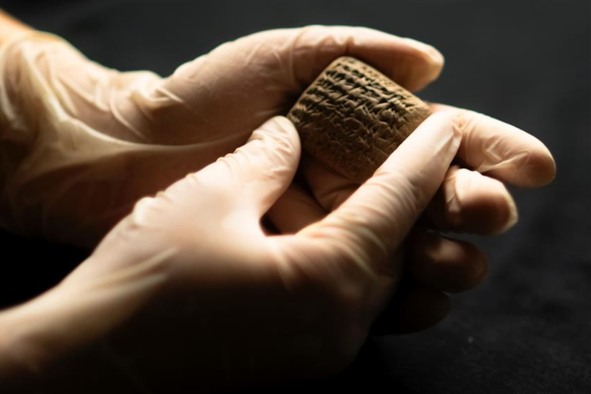A precious ancient scarlet-red dye has been identified on 3,800-year-old textile fragments that were found in a desert cave.
The rare textiles, which consist of uncolored linen and dyed bright red wool pieces, were originally discovered in 2016 in the Cave of Skulls, Israel, west of the Dead Sea in the Judaean Desert.
A team of researchers subsequently analyzed the tiny textile fragments and have now determined that they contain a red dye made from scale insects of the species Kermes vermilio, which was highly valued in the ancient world, according to a study published in the Journal of Archaeological Science: Reports. The authors conclude that these fragments represent the earliest known use of a red dye produced using these kinds of insects.
"Despite the fact that these textile fragments measure no more than 1.5 centimeters [0.6 inches], their significance is immense, as they bear witness to the utilization of scale insects for dyeing textiles during the Middle Bronze Age, the earliest of its kind known to date," the authors wrote in the study.
The color red has been regarded as symbolically significant throughout history by various cultures around the world. Scarlet was considered one of the ancient world's most precious and expensive dyes, alongside royal blue and purple. Scarlet was even mentioned several times in the Bible, in addition to the two other aforementioned colors.
Red dyes were produced from various sources in antiquity, including plants and animals. Some of the most luxurious red dyes were derived from various species of scale insects, including Kermes vermilio.
The two tiny textile fragments that are the subject of the latest study belong to the same artifact. The pieces were among numerous organic objects—such as textiles, yarns, ropes, basketry, leather and wood artifacts—that were found in 2016 during an excavation conducted on behalf of the Israel Antiquities Authority and the Hebrew University of Jerusalem.
All of these organic objects were "remarkably" preserved for millennia due to the dry and relatively stable micro-environmental conditions that are typical of Judaean Desert caves, according to the study.
Despite their tiny size, researchers were intrigued by the tiny red textile fragments because of their color and they were sent off for further analysis, alongside other artifacts from the cave.
Radiocarbon dating indicated that the fragments were from the Middle Bronze Age (1954-1767 B.C.), while analysis of the dye revealed that it was made with the dried bodies of Kermes vermilio insects.
"Identifying the dye in the ancient textile was achieved using High-Performance Liquid Chromatography (HPLC)—a device commonly employed in biology and chemistry laboratories to separate and identify substances in minute quantities, and it also serves archaeology," Naʼama Sukenik, curator of the Organic Material Collection at the Israel Antiquities Authority and lead author of the study, said in a news release.
"This advanced analytical method enabled us to pinpoint the dye's origin down to the exact species of scale insect. Thus, we can determine with high probability that in ancient times, the textile was dyed using a species of Kermes vermilio, which produces kermesic acid, imparting the distinctive red hue."
These small insects are native to the Mediterranean region and are parasitic, feasting on the sap of their host plant.
"In ancient times, the dye was produced from the female scale insect, which lives on the Kermes oak tree (Quercus coccifera)," Sukenik said. "Collecting these Kermes was done in a very short window of time—one month out of the year, in the summer, after the female laid her eggs but before they hatched—when the amount of dye was greatest."
"The short period in which the Kermes could be collected, the difficulty in finding them due to their small size (between 3–8 millimeters), and their camouflage colors that make it difficult to locate them, as well as the small amount of dye that can be produced from them—and on the other hand, the beautiful red hue (scarlet) that can be produced from them for dyeing textiles—made their use highly prestigious."
How the red textile fragments arrived in the Cave of Skulls is somewhat of a mystery. But the find is significant given that very few textiles colored with Kermes insect dye predating the Roman period have been found worldwide. This is despite a wealth of written historical evidence detailing the widespread use of dyeing with scale insects in antiquity.
"The important find bridges the gap between written sources and the archaeological discoveries, providing evidence that the ancient textile dyeing industry was—already at this stage—sufficiently established for dyeing using animals," Sukenik said. "The rare textile is a testament to broad international commercial networks functioning already at this time and indicates the presence of an elite society."
Do you have a tip on a science story that Newsweek should be covering? Do you have a question about archaeology? Let us know via science@newsweek.com.
Disclaimer: The copyright of this article belongs to the original author. Reposting this article is solely for the purpose of information dissemination and does not constitute any investment advice. If there is any infringement, please contact us immediately. We will make corrections or deletions as necessary. Thank you.




